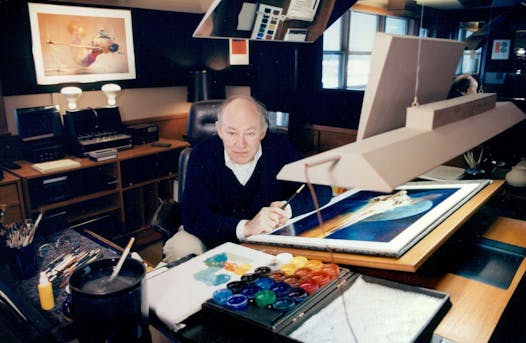A long time ago in a galaxy not so far away lived a painter named John Berkey, who made "Star Wars" posters, science-fiction book covers and many other intergalactic works of art. Although you may not know his name, you've definitely seen his work.
"Not Far-Far Away: John Berkey's Sci-Fi Paintings," an exhibition running through Oct. 6 at the Minneapolis College of Art and Design, showcases the cosmic imagination of an artist who visualized a whole universe right here in the Twin Cities area, from the comfort of his home studio in Excelsior.
Best known for his visions of the original "Star Wars" and the images of the Death Star, he also created visuals for dozens of other movies. But a lot happened before he started producing the work he's best known for.
Born in North Dakota, Berkey took classes at MCAD in the early 1950s, then was employed as an in-house illustrator for Brown and Bigelow, the St. Paul-based national calendar company that kept many Twin Cities artists employed.
For nine years, he produced more than 500 images of the sort of things typically seen in calendars, such as pastoral Americana scenes and historical tableaux, before going out on his own as a freelance illustrator in 1963.
Around the same time, NASA hired him to illustrate astronauts as part of the U.S. space program.
His connection with "Star Wars" happened organically, much like it does in the movies or through pure luck.
Painting the Death Star
According to Berkey, "Star Wars" creator George Lucas contacted him when he was doing magazine and book illustrations.
"He had illustrated book covers for a series of Frederick Pohl science-fiction stories called 'Star Science Fiction,' " said Damon Stanek, a freelance curator and adjunct lecturer at MCAD who organized the show.
"The books were reissued in the 1970s. One of these books has this large spherical orb in the middle ground, and it's said that Lucas saw that and reached out to Berkey. He bought a couple Berkey paintings while he was working on the script."
Berkey wound up producing some sketches for the movie, including a painting that served as a design for the Death Star.
He was already known for other movie posters, including 1974's "The Towering Inferno" and the Jessica Lange version of "King Kong" in 1976, so this was a natural fit.
He also did the poster for the original "Star Trek" movie that reunited Kirk and Spock in 1979.
But he didn't get to do the poster for "Star Wars" because of a legal dispute between 20th Century Fox and Universal Television over work that Berkey had done for the TV series "Battlestar Galactica."
According to Stanek, " 'Star Wars' thought 'Battlestar Galactica' was getting a little close to its story line, and Universal claimed that 'Star Wars' was a little close to a film they had, called 'Silent Running.' Berkey got caught in the middle, so it turned out he didn't really get to work for either."
But his sketches popped up in the film's soundtrack album, spinoff books and even a board game.
'You can feel his enthusiasm'
Years later, David Mandel, a writer for "Seinfeld," "Saturday Night Live" and "Veep," bought a Berkey painting of Luke, Leia and Darth Vader.
Fans of "Seinfeld" will recall that Jerry obsessively collects Superman figurines, as if to continue fulfilling his own teenage superhero dreams. Likewise, Mandel said, "I'm a pretty big 'Star Wars' collector. I've been a fan going way back to when I saw the movie as a kid.
"Hold on, I've got to go look at it," he said via phone from Los Angeles.
He said he thinks that the image is a preliminary sketch for a book cover or movie poster.
"Don't get me wrong, finished pieces are wonderful," he said, "but you get to see the artist's process in these prelim pieces. I hesitate to call them loose, but there's an energy to them in a very great way and you can really feel his enthusiasm for the project."
Pop-culture conference
The MCAD show was organized as part of the Mechademia, an Asian pop culture conference that happens each fall at the school. Stanek put it together with assistance from David Machacek and Kari Alberg of ArtOrg, a Northfield-based organization that put together a 2005 retrospective of Berkey's work.
Berkey, who died in 2008 at age 75, was incredibly prolific and was known for working 12- to 16-hour days.
In doing research for the show, Stanek reached out to the Berkey family and spent some time with his widow, Demi, who invited her into their home. One detail especially caught Stanek's eye.
"He devised this two-mirror contraption so he could sit at his desk but also get some distance from the works," Stanek said. "He didn't feel that some of his works really pulled together as compositions until you got about 6 or 7 feet away from them. It was a way to get that distance without having to get up from the chair."
Similarly, working in Minnesota gave him a creative distance from the entertainment industry, located in an otherworldly galaxy called L.A., somewhere far, far away.
Summer Movie Guide: Virtually all the movies coming to theaters and streaming from May to Labor Day
Music Review: Pet Shop Boys have done it yet again with catchy and bittersweet 'Nonetheless'
John Lithgow takes on the role of the new kid in school for a PBS special celebrating arts education

A Twyla Tharp world premiere is part of Northrop's 2024-25 dance season



